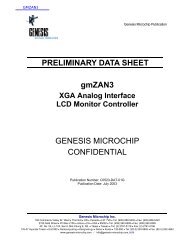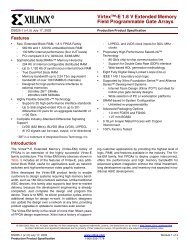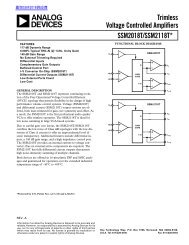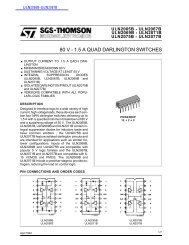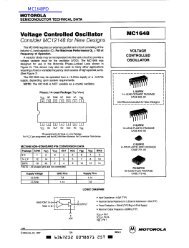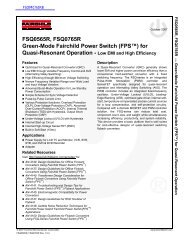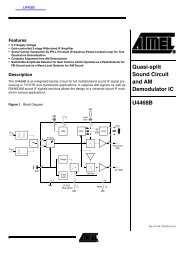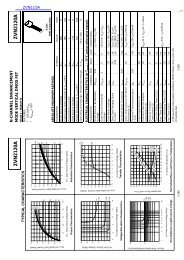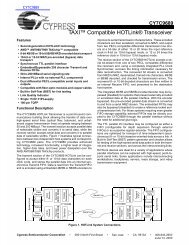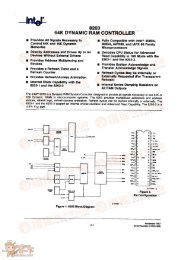Create successful ePaper yourself
Turn your PDF publications into a flip-book with our unique Google optimized e-Paper software.
Table 28: Read Configuration Register Descriptions (Sheet 2 of 2)<br />
14.1 Read Mode (RCR[15])<br />
Numonyx <strong>Wireless</strong> <strong>Flash</strong> <strong>Memory</strong> (<strong>W30</strong>) (<strong>W30</strong>)<br />
All partitions support two high-performance read configurations and RCR[15] sets the<br />
read configuration to one of these modes:<br />
• synchronous burst mode<br />
• asynchronous page mode (default)<br />
Status register, query, and identifier modes support only asynchronous and singlesynchronous<br />
read operations.<br />
14.2 First Access Latency Count (RCR[13:11])<br />
The First Access Latency Count (RCR[13:11]) configuration tells the flash device how<br />
many clocks must elapse from ADV# de-assertion (V IH ) before driving the first data<br />
word onto its data pins. The input clock frequency determines this value. See Table 27,<br />
“Read Configuration Register Definitions” on page 79 for latency values.<br />
Figure 38 shows data output latency from ADV# assertion for different latencies. Refer<br />
to Section 14.2.1, “Latency Count Settings” on page 81 for Latency Code Settings.<br />
Note: Other First Access Latency Configuration settings are reserved.<br />
)<br />
Bit Name Description1 Notes<br />
3<br />
2-0<br />
BW<br />
Burst Wrap<br />
BL[2:0]<br />
Burst Length<br />
0 = Wrap bursts within burst length set by CR[2:0]<br />
1 = Don’t wrap accesses within burst length set by CR[2:0].(Default)<br />
001 = 4-Word Burst<br />
010 = 8-Word Burst<br />
011 = 16-Word Burst (Available on the 130 nm lithography)<br />
111 = Continuous Burst (Default)<br />
Notes:<br />
1. Undocumented combinations of bits are reserved by Numonyx for future implementations.<br />
2. Synchronous and page read mode configurations affect reads from main blocks and parameter blocks. Status Register<br />
and configuration reads support single read cycles. RCR[15]=1 disables the configuration set by RCR[14:0].<br />
3. Data is not ready when WAIT is asserted.<br />
4. Set the synchronous burst length. In asynchronous page mode, the burst length equals four words.<br />
5. Set all reserved Read Configuration Register bits to zero.<br />
6. Setting the Read Configuration Register for synchronous burst-mode with a latency count of 2 (RCR[13:11] = 010),<br />
data hold for 2 clocks (RCR[9] = 1), and WAIT asserted one data cycle before delay (RCR[8] =1) is not supported.<br />
Figure 38: First Access Latency Configuration<br />
CLK [C]<br />
Address [A]<br />
ADV# [V]<br />
D[15:0] [Q]<br />
D[15:0] [Q]<br />
D[15:0] [Q]<br />
D[15:0] [Q]<br />
Valid<br />
Address<br />
Code 2<br />
Code 3<br />
Code 4<br />
Code 5<br />
Valid<br />
Output<br />
Datasheet November 2007<br />
80 Order Number: 290702-13<br />
Valid<br />
Output<br />
Valid<br />
Output<br />
Valid<br />
Output<br />
Valid<br />
Output<br />
Valid<br />
Output<br />
Valid<br />
Output<br />
Valid<br />
Output<br />
Valid<br />
Output<br />
Valid<br />
Output<br />
Valid<br />
Output<br />
Valid<br />
Output<br />
Valid<br />
Output<br />
Valid<br />
Output<br />
Valid<br />
Output<br />
Valid<br />
Output<br />
Valid<br />
Output<br />
Valid<br />
Output<br />
4



